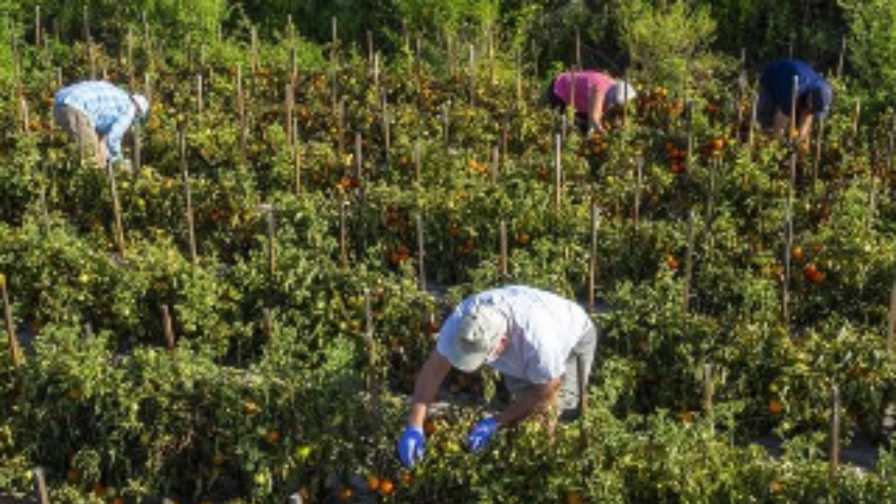Silver Linings for Tomato Industry in Wake of Coronavirus

Volunteers at Mecca Farms in Lantana, FL, glean yellow tomatoes to give to families out of work.
Photo courtesy of the Palm Beach Post
Florida’s tomato growers were having one of their best seasons in recent memory before the COVID-19 crisis hit in March 2020. Mother Nature had been cooperating in Florida but not so much in Mexico. As a result, imports of Mexican tomatoes were down, and prices were up. The recently renegotiated tomato suspension agreement also has been providing some welcome relief to the Florida industry. But as states around the country began issuing stay-at-home orders in early March, demand for Florida tomatoes nearly disappeared overnight.
For many Florida tomato growers, up to 80% of their crop is destined for the food service market, which includes restaurants, hotels, schools, cruise lines, theme parks, etc. The sudden closure of many of these businesses brought demand to a virtual standstill. From mid-March to mid-April, growers were left with tens of millions of pounds of unsold tomatoes, which either had to be left unharvested to rot on the vine or packed but unable to be sold. For those tomatoes that could still find a home, selling prices were typically well below the cost of production.
Some growers responded by opening farmers markets outside their packing sheds, selling 25-pound boxes of tomatoes at salvage prices to the local community. Millions of pounds of tomatoes also were able to be donated. Food banks in Florida were certainly well stocked with tomatoes and other fresh fruits and vegetables this spring, as growers of blueberries, squash, cucumbers, green beans, cabbage, and other commodities found themselves in a similar bind as tomato growers.
For Florida’s fruit and vegetable growers, the COVID-19 crisis exacerbated an even larger crisis for the industry, which is the fight against unfair Mexican competition. The tomato industry has been at the vanguard of this fight for the better part of three decades, but many other Florida products have only just started to feel the impact in recent years.
The COVID-19 lockdowns exposed the challenge for many Florida growers as they tried to shift product destined for the food service sector to the retail grocery sector. Unfortunately, it was all too common, even within Florida, to find imported product on store shelves at the same time as growers throughout the state were having to disc fresh produce into the ground. As Jon Esformes, CEO of Pacific Tomato Growers in Palmetto, FL, stated in an early-April interview: “For retailers within a couple of miles of my farms and packing facilities to have 70% of the tomatoes on their shelves be imported tomatoes while we are throwing away these beautiful tomatoes in the field is awfully painful.”
While this was an unprecedented shock to supply chains, it has served to highlight the increasing role that imported fruits and vegetables play in the American diet. In fact, this crisis has sparked a broader discussion about global supply chains and America’s reliance on vital imported goods, particularly medical supplies and pharmaceutical inputs. In the midst of a pandemic, there is hardly anything as vital as medical supplies and pharmaceuticals, but the country’s food supply is certainly one of those things.
Florida is the primary domestic producer of many of the country’s fruits and vegetables from November through May. But as Florida farmers continue to exit the industry, due in part to unfair Mexican competition, the U.S. has become increasingly reliant on imported fruits and vegetables for six months out of the year (and in some cases, it’s becoming a year-round phenomenon).
Imports will always be a component of the U.S. fruit and vegetable trade since they help provide a diversified supply chain, but the nation’s food supply will no longer be diversified if those same imports gradually force out domestic producers. Indeed, that’s what been happening to growers in Florida. If current trend lines continue, the U.S. will be almost completely reliant on imported fruits and vegetables for a big chunk of the year.
There are silver linings and opportunities that come out of any crisis. One silver lining may be that Americans are now paying more attention to where things come from, whether that’s medical supplies or the food we eat. With so much media coverage of farmers having to destroy their crops, and of grocery stores being sold out of essential items, and of an increasing number of Americans facing food insecurity, this is a unique moment for the country to recognize the importance of sustaining domestic food production. This is an opportunity for American growers to reinvigorate the conversation around buying local and supporting U.S. farmers.










